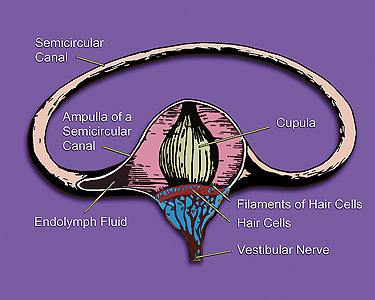Benign paroxysmal positional vertigo pathophysiology
|
Benign paroxysmal positional vertigo Microchapters |
|
Differentiating Benign Paroxysmal Positional Vertigo from other Diseases |
|---|
|
Diagnosis |
|
Treatment |
|
Case Studies |
|
Benign paroxysmal positional vertigo pathophysiology On the Web |
|
American Roentgen Ray Society Images of Benign paroxysmal positional vertigo pathophysiology |
|
Benign paroxysmal positional vertigo pathophysiology in the news |
|
Blogs on Benign paroxysmal positional vertigo pathophysiology |
|
Risk calculators and risk factors for Benign paroxysmal positional vertigo pathophysiology |
Editor-In-Chief: C. Michael Gibson, M.S., M.D. [1]; Associate Editor(s)-in-Chief: Fahimeh Shojaei, M.D.
Overview
It is understood that BPPV is the result of free floating calcium carbonate crystal formation (canalolithiasis) inside the semicircular canals. Movement of these otoconia with head movement will result in inappropriate stimulation of hair cells following movement of the endolymph. In some studies it was demonstrated that people with BPPV in their first degree family are at more risk of development of the disease themselves. One of the theories behind the familial aspect of BPPV is that these families might have less adhesive gelatinous matrix of the utricular macula which predisposed them to BPPV. On microscopic histopathological analysis, crystals with combination of a gelatinous matrix and calcium carbonate are characteristic findings of otoconia in BPPV.
Pathophysiology
 |
 |
Physiology
The normal physiology of semicircular canals can be understood as follows:[1]
- One of the most important inner ear structures are horizontal, superior (anterior) and posterior semicircular canals.
- There is an osseous ampullae at the end of each semicircular canal which consist of ampulla crest, the crista ampullaris, and hair cells.
- Semicircular canals are hollow structures with endolymph inside them.
- The movement of endolymph following changing head position will stimulate hair cells to send an impulse to the brain, determining the head position.
- The horizontal semicircular canal detects the head movement in the transverse plane (head turning to right and left).
- The superior (anterior) semicircular canal detects head rotational movement in the sagittal plane (head nodding).
- The posterior semicircular canal detects head rotational movement in the coronal plane (head touching the shoulders)
Pathogenesis
- It is understood that BPPV is the result of free floating calcium carbonate crystal formation (canalolithiasis) inside the semicircular canals.[2]
- These debris are normally attached to the membrane of utriculus, a gravity-sensitive structures in the inner ear.
- Movement of these otoconia with head movement will result in inappropriate stimulation of hair cells following movement of the endolymph.
- The inappropriate impulses to the brain will result in false sensation of spinning.
Genetics
- The development of idiopathic BPPV may be the result of multiple genetic mutations.[3][4]
- In some studies it was demonstrated that people with BPPV in their first degree family are at more risk of development of the disease themselves.
- One of the theories behind the familial aspect of BPPV is that these families might have less adhesive gelatinous matrix of the utricular macula which predisposed them to BPPV.
Associated Conditions
Conditions associated with BPPV include:[5][6]
Gross Pathology
- there is no gross pathology findings with BPPV.
Microscopic Pathology
- On microscopic histopathological analysis, crystals with combination of a gelatinous matrix and calcium carbonate are characteristic findings of otoconia in BPPV.[2]
References
- ↑ Chester JB (July 1991). "Whiplash, postural control, and the inner ear". Spine. 16 (7): 716–20. PMID 1925743.
- ↑ 2.0 2.1 Hornibrook J (2011). "Benign Paroxysmal Positional Vertigo (BPPV): History, Pathophysiology, Office Treatment and Future Directions". Int J Otolaryngol. 2011: 835671. doi:10.1155/2011/835671. PMC 3144715. PMID 21808648.
- ↑ Gizzi M, Ayyagari S, Khattar V (November 1998). "The familial incidence of benign paroxysmal positional vertigo". Acta Otolaryngol. 118 (6): 774–7. PMID 9870618.
- ↑ Gizzi MS, Peddareddygari LR, Grewal RP (2015). "A familial form of benign paroxysmal positional vertigo maps to chromosome 15". Int. J. Neurosci. 125 (8): 593–6. doi:10.3109/00207454.2014.953157. PMID 25135283.
- ↑ Cohen, Helen S.; Kimball, Kay T.; Stewart, Michael G. (2004). "Benign Paroxysmal Positional Vertigo and Comorbid Conditions". ORL. 66 (1): 11–15. doi:10.1159/000077227. ISSN 0301-1569.
- ↑ Chu, Chia-Huei; Liu, Chia-Jen; Lin, Liang-Yu; Chen, Tzeng-Ji; Wang, Shuu-Jiun (2015). "Migraine is associated with an increased risk for benign paroxysmal positional vertigo: a nationwide population-based study". The Journal of Headache and Pain. 16 (1). doi:10.1186/s10194-015-0547-z. ISSN 1129-2369.